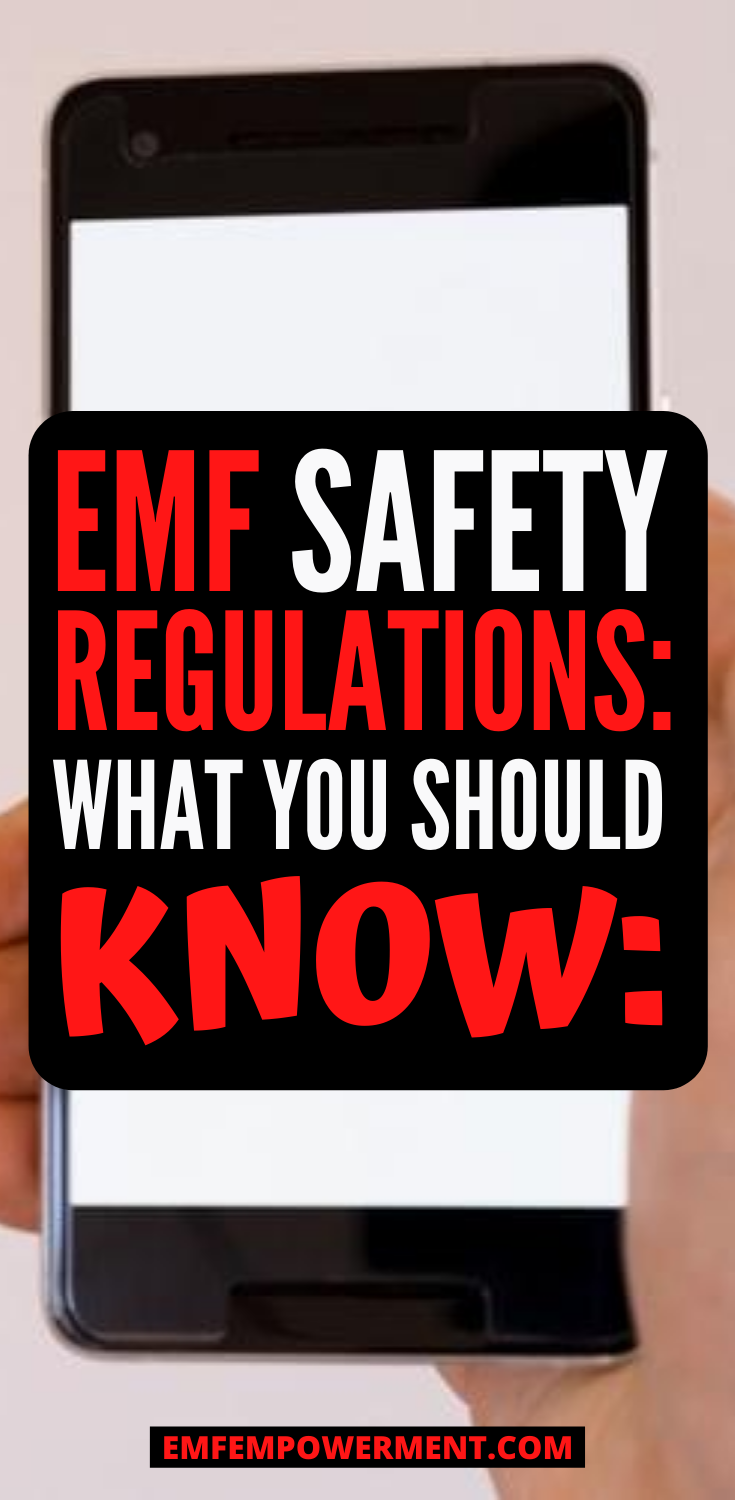On April 3, 1973, the first mobile phone was created. Since then, cell phone technology has…
Are EMF Safety Regulations Really Keeping Us Safe?

*We may earn a commission for purchases made using our links. Please see our disclosure to learn more.
If EMF radiation is so bad, why don’t governments regulate it?
The reality is that they do. Those standards, however, often do not go far enough, and they fail to take important factors into consideration. Let’s take a look at who actually designs these standards, and what can be done to make them more effective.
WHO EMF Standards Framework
The World Health Organization (WHO) has created an EMF Standards Framework for countries to reference when designing their own EMF regulations. The WHO’s International Association for Research on Cancer (IARC) has designed both RF and ELF-EMF radiation as “possibly carcinogenic to humans,” and it encourages countries to adopt international standards regarding EMF regulations. The framework was created, however, for those countries that would prefer to set their own standards.
The framework encourages countries to set different occupational limits and public exposure limits. Factors to be taken into consideration include exposure frequency, level, duration, and whether the exposure is whole-body or partial-body. The framework also recommends looking at and evaluating existing scientific research. It also recommends periodically revisiting and updating recommendations based on newly available data.
Regulations by country
- United States. In the United States, national exposure limits are regulated by the Federal Communications Commission (FCC). The limits were set in 1996 (you read that right — nearly 25 years ago), and they cover the 300 kHz to 100 GHz range.
- Canada. In Canada, national exposure limits are set by Health Canada. The Canadian government set its limits in 1999 (still over 20 years ago,) and they regulate the 3kHz to 300 GHz range.
- United Kingdom. The United Kingdom’s voluntary regulations for mobile phone operators were set in 2000. Meanwhile, their guidelines surrounding occupational and public exposure were developed all the way back in 1993. The UK’s guidelines cover frequencies ranging from 3kHz to 300GHz.
- China. China’s standards were developed by the Ministry of Health in the late 80s. Compliance is mandatory, and the standards regulate 100kHz to 300 GHz.
- Australia. Australia has two sets of regulations surrounding EMF radiation. Their guidelines on exposure to power lines (50/60Hz electric and magnetic fields) were developed in 1989. Their standards on radiocommunications were updated in 2003, making them the most updated on our list.
To learn about regulations in other countries, or to see specific regulations for different frequencies, see the WHO’s International EMF Project. Simply select your country from the dropdown menu and select “Go”.
Problems with government regulations
Most country’s regulations fail to take into account a few important considerations.
- Cumulative exposure. This is particularly relevant for the younger generations, who have been using cell phones and tablets since they were old enough to read. A person’s exposure over the course of their lifetime does make a difference — that radiation adds up. If a person is regularly exposed to high levels of EMF radiation over a number of years, they are more likely to develop health problems as a result than someone who is only exposed sporadically. It’s not a guarantee and there are always exceptions to the rule, but compare it to smoking. Smoking one cigarette over the course of a lifetime is far less likely to cause health effects than smoking a pack a day for that same length of time.
- Multiple devices. Government regulations are on a per-device basis, meaning that no one device will exceed certain EMF production limits. Most people are exposed to much more than one device at a time, however. We have power lines, smart appliances, smart meters, WiFi, cell phones, and so much more surrounding us at any given moment. Sure, each device may only be emitting a small amount of EMF radiation, but when they’re all combined the true amount you’re exposed to is much higher.
- Lack of research. EMF research, in general, is severely lacking. Studies that do exist indicate that EMF radiation exposure may have serious health implications — at the very least, it’s safe to say that more research is certainly warranted. So how, then, can we derive safety standards based on the limited amount of existing data, and feel at all confident that those standards are effective?
- Thermal effect. Current EMF regulations are centered around the thermal effect. The thermal effect is the tendency of radiation to cause burns to the skin at certain exposure levels. Existing EMF regulations generally strive to find levels of EMF radiation exposure that won’t cause damage to the skin. They don’t even consider other health effects or the levels at which exposure can become problematic in other ways.
Safe EMF levels
Given that the research is so lacking, it’s perhaps not surprising that researchers really haven’t established a baseline safe level of EMF radiation to be exposed to. And even if it did, it seems likely that with multiple devices present at all times, many of us would consistently be over the limit. The argument could be and has been made that the only safe levels of EMF radiation are the levels that we are exposed to naturally, from the solar and magnetic radiation.
One reason natural radiation is possibly safer is that our bodies have evolved over time to withstand the comparatively tiny amounts of EMF radiation we come across naturally. Manmade EMF radiation is relatively new, and we are exposed in much higher doses than our bodies are used to or capable of processing.
Reducing your EMF exposure
On that note, the best thing you can do is to lower your EMF exposure as much as possible. Here are a few suggestions for how to do just that:
- Switch to wired internet. WiFi produces a significant amount of RF-EMF radiation that blankets the entire signal area. The best thing you can do to reduce this is to cut out WiFi altogether and stick with a wired internet connection. If the prospect of connecting all your devices to a wire feels daunting, see our guide to going wired.
- Use a wired headset to talk on the phone. When you talk on your cell phone, it is broadcasting RF-EMF radiation directly at your brain. Perhaps, for this reason, cell phone usage has been tied to brain tumors. To reduce your exposure, you need to increase the distance between your phone and your body at all times, including when the phone is in use. To do this while making a call, you can use a wired headset. Be sure it’s wired — Bluetooth presents problems of its own, which we’ll discuss momentarily.
- Install a smart meter cover. Smart meters have revolutionized municipal works departments by allowing meter readers to scan meters electronically from the street. These meters communicate with a base device using radio waves. Unfortunately, these radio waves are a form of RF-EMF radiation, and a pretty high dose of it, at that. If your city uses smart meters, you can protect your home by installing a smart meter cover around the device. This will help prevent it from sending radiation outward while still allowing a signal to pass through. You can also paint the corresponding interior wall with EMF paint to prevent radiation from the meter from entering your home. To learn more, see Smart Meter Radiation: What You Should Know.
- Put a protective canopy over your bed. Think of your bedroom as your sanctuary from EMF radiation. Ideally, you should strive to make this as much of an EMF-free place as possible, so your body can fully rest and restore itself. If there’s too much nearby EMF radiation for that to be realistic, however, consider investing in a protective bed canopy. These canopies, when installed correctly, shield you from nearly all surrounding EMF radiation while you sleep.
- Limit your use of Bluetooth. From wireless game controllers to keyboards and headphones, Bluetooth is very much a part of everyday life. The problem is that Bluetooth is another form of RF-EMF radiation. If you are using Bluetooth devices throughout your home, you are going to be increasing your exposure to EMF radiation. Try to stick with wired devices when possible, and only switch Bluetooth on when absolutely necessary.
For other ways to reduce your exposure and protect your family, see our guide to whole-house protection. You can’t cut out EMF radiation completely, but you can at least minimize the levels present in your own home.
Final thoughts
The fact of the matter is, most governments do not go far enough to protect their citizens from EMF radiation. Standards are lacking and based on outdated data. It’s therefore important for each person to take steps to protect themselves and their family. Whole-house EMF protection can be a hefty investment, but it’s absolutely worth it for your health. 



